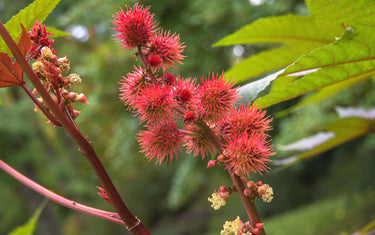5 min read / 25 February 2023 / Laura Garvin Gomez
The Benefits of Castor Oil for Skin
Discover the nourishing and rejuvenating benefits of castor oil for your skin with our comprehensive guide.
Share this post

Castor oil may not be something you associate with skin care, but believers of natural medicine can’t speak highly enough about it and find use for it in a variety of ways.
After all, it is stacked with lots of healthy fatty acids, antioxidants, antimicrobial and anti-inflammatory properties that can be very helpful for improving the condition of your hair, skin and nails.
Here we explain more about castor oil, the benefits it has to offer, how to use it and more.
What is castor oil?Castor oil is derived by pressing the seeds of the castor oil plant that is typically found in India, Eastern Africa and the Mediterranean. It is noticeably thicker that most other types of essential oil, but compared to other vegetable oils it also has high levels of fatty acids and vitamin E. |
Is castor oil good for skin?
It is highly likely that you are already using a cosmetic product for your skin that contains castor oil (look for an ingredient called Ricinus Communis, which is the name of the castor plant). Lip balms and lipsticks often contain castor oil as it is good at nourishing the skin on the lips.
Castor oil contains triglycerides, which can help to smooth skin as it helps to retain moisture, while also working as an antioxidant. The oil can also draw water from the air and trip it into the skin, acting as a humectant, making it more difficult for moisture to evaporate. Your body will benefit more from this during the colder parts of the year as your skin contends with changing temperatures indoors and outdoors.
What are the castor oil benefits for skin?
Some of the best benefits castor oil may be able to offer your skin include:
- Moisturises the skin: If you suffer from dry skin, castor oil can be a good choice as it is a triglyceride, which helps to keep moisture in the skin for longer, smoothing the skin for a better appearance.
- Better hydration: Working as a humectant, castor oil draws water from the air to hydrate the skin, which is helpful during the winter to prevent dry and broken skin from developing.
- It offers skin protection: Castor oil is an antioxidant, helping the skin to recover when faced with exposure to UV rays and other environmental elements throughout the day.
- Can be good for the scalp: It is easy to forget that your scalp is also skin and not something separate and castor oil can also be used here to improve scalp health and encourage hair growth.
- Reduces puffiness: Thanks to castor oil’s inflammatory properties it could help to reduce inflammation around the eyes, which may please anyone who regularly experiences swollen puffy eyes.
- Combats acne: The antibacterial properties found in castor oil may help to prevent disease-causing bacteria and fungi from growing, which could prevent the build of sebum that leads to acne.

What is the best castor oil for skin?
You could try including this castor carrier oil as part of your daily skincare routine. Along with its omega-9 benefits and high levels of ricinoleic acid, it can reduce swelling and pain caused by inflammation, while ensuring moisture stays locked in for longer. Massage it directly into the skin, use it to boost shine and calm hair frizz, or it also works every effectively as a makeup remover when applied to a cotton pad. Learn more about the benefits and uses of castor oil.
How to use castor oil for skin
While castor oil is a carrier oil and not an essential oil, it is recommended that you dilute it before applying it to your skin as it can take some time for castor oil to fully absorb into the skin. Carrier oils like grapeseed oil and coconut oil absorb fast. You should also carry out a patch test on a small area of your body to ensure it doesn’t produce any negative reactions.
To carry out a patch test, first dilute the oil (using a 1:1 ratio) and apply to a small area of skin on the inner forearm before covering it with a plaster. If there is no allergic reaction after 24 hours, the oil should be fine to use elsewhere.
However, if you experience any redness, itchiness or inflammation, wash off the castor oil using warm soapy water right away. You can then use the castor oil on other parts of your skin by:
- Cleansing and drying the part of the skin you are applying the oil to.
- Adding a couple of drops of the diluted castor oil to your fingertips.
- Dotting it onto the area of skin you want to treat before gently massaging the castor oil using a circular motion. Avoid contact with your eyes before the oil is washed off.
- Leave the oil on your skin for a minimum of 30 minutes or you can apply before bed and let it absorb overnight.
- Use warm soapy water to wash off any excess left on the skin and apply some moisturisers to lock in the hydration.
This is a process you can repeat 1-2 times a week by including it as part of your skincare routine.
Are there any side effects to using castor oil?
As with any carrier oil or essential oil you should always be aware of any potential side effects it could cause.
Castor oil is generally considered to be safe to use, although it can cause an allergic reaction on some skin types, which is why it is important to carry out a patch test. If you experience any itching, swelling or difficulty breathing, stop using the oil and speak with your doctor.
Try to avoid getting castor oil in your eye as it can cause some discomfort. If this does happen, rinse it straight away with warm water.

Castor oil is more commonly used than you are probably aware of and its inclusion in every day cosmetic products means it may already be helping to improve the condition of your skin. It’s anti-inflammatory, antimicrobial and antioxidant properties make it a fantastic moisturiser and using the oil by itself, rather than as an ingredient in a cosmetic product, may even lead to better results. Make sure you carry out a patch test before use and if all is okay you can use it as a secret weapon to make your skin look and feel great.
| ANALYTICAL DETAILS | RANGE % |
|---|---|
| APPEARANCE | OILY LIQUID |
| ODOUR | ODOURLESS |
| COLOUR | CLEAR - YELLOW |
| COLOUR LOVIBOND | ≤2R, ≤20Y |
| SPECIFIC GRAVITY @ 20℃ | 0.915-0.925 |
| RELATIVE DENISTY @ 15℃ | 0.957-0.969 |
| REFRACTIVE INDEX @ 20℃ | 1.477- 1.481 |
| FREE FATTY ACID (% AS OLEIC) | ≤ 1.0 |
| PEROXIDE VALUE (MEQ 02/ KG) | ≤ 10.0 |
| IODINE VALUE (G/ 1 OOG) | 82.0 - 90.0 |
| ACID VALUE | ≤2.0 |
| SAPONIFICATION VALUE (MG KOH/GR) | 177.0- 187.0 |
| UNSAPONIFIABLE MATTER | ≤1.0 |
| ACETYL VALUE (MGKOH/G) | 140.0- 150.0 |
| HYDROXL VALUE (MGKOH/G) | 160.0- 169.0 |
| FATTY ACID PROFILE | RANGE % | |
|---|---|---|
| C-CHAIN | ACID NAME | |
| C16:0 | PALMITIC | 1.0 - 2.0 |
| C18:0 | STEARIC | 1.0 - 3.0 |
| C18:1 | OLEIC | 2.0 - 5.0 |
| C18:1 | RICINOLEIC | 85.0 - 90.0 |
| C18:2 | LINOLEIC | 3.0 - 7.0 |









